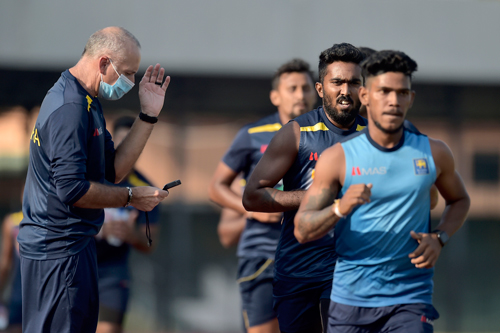Is it the solution to our cricketers’ fitness woes?
Underscoring the belief in cricketing circles that Sri Lanka’s current poor performances and high injury rate in the international arena are largely due to the cricketers poor fitness levels, Sri Lanka Cricket (SLC) has introduced the 2km test for those aspiring for selection. The benchmark for passing this test has been set at 8 minutes and 35 seconds. In other words a cricketer has to run two kilometres in under 8 minutes 35 seconds if he is to be considered for selection.

Sri Lanka cricketers were taken to the Sugathadasa Stadium last week for a 2kilometre run, as part of the new fitness training programme - Pic SLC
SLC needs to further examine whether the criteria of running 2 kilometres under 8 minutes and 35 seconds alone is sufficient to determine whether a player can be labelled “fit” or “unfit”.
Fitness Demands For Cricket
The bowlers, batsmen and fielders all need to display intermittent explosive efforts with relatively prolonged rest in between such efforts during the game. Speed and agility are important for running between the wickets and fielding in the infield while horizontal and rotational power is needed for batsmen, bowlers and fielders in the outfield. A level of aerobic endurance (what is tested through the 2km test) is required in order to recover efficiently between explosive efforts and breaks in the game, especially for Test Cricket.
Long Slow Distance Running and Speed Performance
Too much medium/long distance running has proven to make players slower. While aerobic endurance (2km test) has a certain level of importance for cricket to help players recover from explosive activities during a cricket game, caution needs to be applied in order not to compromise sprint speed and power at the expense of developing aerobic endurance (2km test).
One can understand this phenomenon a little more if one imagines the following scenario. If one is faced with the choice of choosing between Usain Bolt and the world’s number one marathon runner for your cricket team who would you choose? The answer is quite straightforward. Bolt would be quicker between the wickets, have a stronger arm and therefore more effective in the outfield, ability to jump higher to take a catch overhead in the infield, and have the ability to clear the ropes with his explosive power while batting, compared to the marathon runner who will be much weaker in all these areas.
Strength and Conditioning coach Eric Cresey states “Long slow distance running is literally a death march to developing speed and power for sports performance”
Strength Training
A stronger player will naturally be more resilient and less likely to break down than a weaker player. Sub maximal efforts (meaning actions which don’t require 100% effort) on the field such as throwing from the outfield, cruising between wickets for a couple of runs, driving a ball to extra cover will be easier on a stronger player than a weaker player. Stronger players are typically better able to tolerate the cumulative workloads of training, practices and games thus reducing potential for injury.
Strength underpins the development of all other training qualities such as speed, power, aerobic endurance and injury prevention. While aerobic endurance (2km test) is important, research indicates that proper strength training has a greater co- relationship in the prevention of injuries than excessive running fitness.
Body Fat and Performance
A player carrying excess body fat will have his speed and agility adversely affected and will struggle to cover more ground on the field. It will also hamper his running speed between the wickets, have more impact on his joints as well as fatigue setting in quicker during training and games. Nothing affects sport’s performance more than excess body fat.
It could sometimes make the difference between winning or losing a match and sometimes even a World Cup. A classic example of this was the 2003 World Cup semifinal where Aravinda de Silva who was still batting at his brilliant best, struggled to complete a single as he had put on some extra kgs since the 96 World Cup. Despite not showing any decline in his exceptional batting abilities, having lost a second or two of his running speed and getting run out in the semifinals may have made all the difference in Sri Lanka winning or not winning the 2003 World Cup. It is no co-incidence that Aravinda de Silva who is undoubtedly one of the best batsmen Sri Lanka ever produced was at his peak during the years 1995 to 1998 when he was leaner and fitter.
Non Negotiables
Managing one’s body fat is the only thing a player has 100% control over. Excess body fat is a non-negotiable and probably the only physical aspect where a player should be pressured to meet the required benchmark, or be at the risk of being dropped from the team.
Excess body fat will hamper all other areas of fitness such as endurance, speed, agility, power, injury prevention and concentration. There is a direct relationship between a player’s body fat percentage and his nutrition. Poor nutrition habits mean higher body fat levels.
The lack of discipline and compliance in the nutrition area in many national cricketers was also mentioned in a recent television interview by former national selector Asantha de Mel.
Should Players be dropped for not reaching fitness benchmarks?
The 2km test can only be one of many tests that one uses to make judgments about a player with the most important being how well they play in their position and contribute to the team. Are we only testing aerobic endurance (2km test) of the players neglecting testing other key fitness components such as strength, speed and power? Can a player who passes the 2km test be labelled as “fit” if he lacks the other physical competencies such as strength, speed and power? Strength, speed and power are equally if not more important physical attributes needed to make a fit and robust cricketer. It is important that players are periodically monitored in all aspects of fitness mentioned above and not only the 2km aerobic test.
How benchmarks are established and players monitored/prepared for those benchmarks is another important aspect to be considered. However it is best not to completely write off players who don’t meet the benchmarks. How a player performs in relation to the benchmark only provides an individual profile of physical capacity from which the strength and conditioning coach can develop a specific programme to help the player to improve his performance and reach the benchmark.
It should also be noted that in most cases a slower and less powerful player will perform better on the 2km test compared to a more faster and powerful player.
Training purely for the 2km test could hamper performance. The concern with the extra hype over the 2km test is that players will start to train to pass the 2km test and not train specific to the demands of the game neglecting other vital areas of fitness such as strength, speed, agility and power as well as their cricketing skills.
The 2km test is a good test to monitor general aerobic endurance, but has very little specificity to cricket. Very rarely does a cricketer’s heart rate go up to the extent it does in the 2km test.
With most players you could probably make a super fit cricketer by doing nothing but speed, strength and power work, and playing cricket instead of doing extensive long slow distance running fitness.
While it is important to perform fitness tests, what is more important is what the fitness coach does with the test numbers to structure the fitness programme and improve the fitness components that the player is lacking in.
 Bilal Yusuf is an experienced and qualified Strength & Conditioning coach having trained many national level athletes from a variety of sports. He is the founder of Sri Lanka’s first ever High Performance Training Center, Athlete Unleashed. He is also a qualified rugby coach having coached at club and school level. Bilal can be contacted at athleteunleashed@gmail.com Bilal Yusuf is an experienced and qualified Strength & Conditioning coach having trained many national level athletes from a variety of sports. He is the founder of Sri Lanka’s first ever High Performance Training Center, Athlete Unleashed. He is also a qualified rugby coach having coached at club and school level. Bilal can be contacted at athleteunleashed@gmail.com | |



